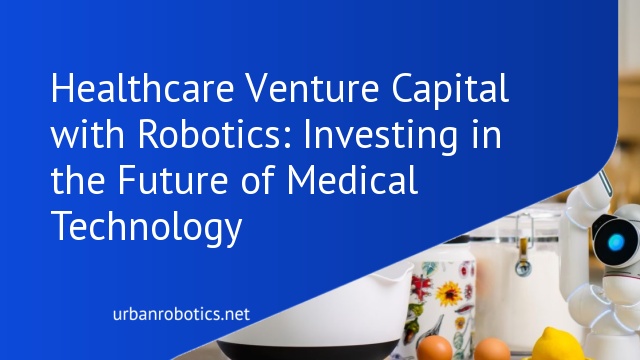Understanding Healthcare Venture Capital
Healthcare venture capital refers to investments made by VC firms in early-stage startups within the healthcare sector. These investments target companies developing innovative technologies, products, or services aimed at improving healthcare delivery and outcomes. VCs look for high-growth potential, disruptive innovation, and strong management teams.
Investments focus on various segments:
- Digital Health: Companies developing telemedicine, health IT, and wearable devices.
- Biotechnology: Firms working on drug discovery, gene therapy, and personalized medicine.
- Medical Devices: Startups creating innovative diagnostic equipment and treatment tools.
- Health Services: Businesses offering healthcare solutions such as patient management systems and clinical services.
Healthcare venture capital plays a pivotal role in bringing groundbreaking technologies to market. It’s particularly relevant as we see a rise in the development of healthcare robotics, driven by the increased focus on automation to enhance efficiency and patient care.
The Role Of Robotics In Healthcare
Robotics has transformed healthcare by introducing advanced technologies and automated systems. These innovations streamline procedures and improve patient care.
Key Innovations In Robotic Healthcare
Several key innovations have emerged in robotic healthcare. Surgical robots, like the da Vinci Surgical System, enhance precision in minimally invasive surgeries. Rehabilitation robots assist patients in regaining mobility and strength post-injury. Diagnostic robots, integrating AI, identify diseases and conditions faster and more accurately. These robots not only improve efficiency but also reduce human error in medical procedures.
Impact On Patient Care And Outcomes
Robotics significantly impacts patient care and outcomes. Robotic-assisted surgeries lead to shorter recovery times and reduced pain. Automated medication dispensers ensure patients receive accurate doses, minimizing errors. Rehabilitation robots provide consistent and personalized therapy, enhancing recovery. These advancements contribute to higher patient satisfaction and better health outcomes, reinforcing robotics’ crucial role in modern healthcare.
Investing In Healthcare Robotics
Investing in healthcare robotics presents a promising opportunity to revolutionize patient care and efficiency. We’ll explore market trends, key players, and risk assessment strategies.
Market Trends And Opportunities
The healthcare robotics market is growing rapidly, estimated to reach $6.5 billion by 2025. Advances in AI, machine learning, and sensor technologies are driving this growth. Key opportunities include surgical robots, rehabilitation robots, and diagnostic robots. With an aging population and increased demand for precision medicine, investment in these areas is likely to yield substantial returns.
Key Players And Startups
Top players in healthcare robotics include companies like Intuitive Surgical, known for its da Vinci Surgical System, and Medtronic, which offers robotic-assisted surgery solutions. Noteworthy startups like Cyberdyne, specializing in HAL (Hybrid Assistive Limb) exoskeletons, and Vicarious Surgical, aiming to enhance minimally invasive surgery, are also making significant strides. These entities are at the forefront of innovation, pushing the boundaries of what’s possible in medical robotics.
Risk Assessment And Mitigation
Investing in healthcare robotics carries inherent risks, including regulatory hurdles, technological obsolescence, and high development costs. Effective risk mitigation strategies involve conducting thorough due diligence, partnering with regulatory experts, and investing in scalable technologies. Diversifying the investment portfolio across different types of medical robotics can also help mitigate potential losses, ensuring a balanced and resilient investment strategy.
Case Studies: Successful Healthcare Robotics Ventures
Let’s explore case studies that underscore the success and potential of healthcare robotics ventures backed by venture capital.
Notable Venture Capital Investments
Several notable investments in healthcare robotics have paid off significantly. Intuitive Surgical’s da Vinci Surgical System initially gained traction with substantial venture capital support, leading to its widespread adoption in surgeries. Medtronic’s acquisition of Mazor Robotics, a leader in spine surgery robots, is another example showcasing the lucrative returns of investing in this sector. More recently, Vicarious Surgical raised $100 million in Series B funding, emphasizing ongoing interest in robotic surgical solutions. These investments illustrate promising opportunities in healthcare robotics.
Lessons Learned
Our analysis of these successful ventures highlights key lessons. First, investor support is crucial for early-stage development, as seen with Intuitive Surgical and Vicarious Surgical. Second, strategic acquisitions, such as Medtronic’s purchase of Mazor Robotics, can accelerate market presence and technological advancement. Lastly, continuous innovation in AI and sensor technologies drives success, emphasizing the importance of staying at the forefront of tech developments. Investing in healthcare robotics requires understanding these core principles to maximize returns and contribute to medical advancements.
The Future Of Healthcare Venture Capital With Robotics
Healthcare venture capital continues to evolve rapidly, especially with the integration of advanced robotics. Investors focus on the potential of cutting-edge technologies to revolutionize patient care and drive significant returns.
Emerging Technologies
We observe several emerging technologies shaping the future of healthcare robotics. AI integration in robotic systems enhances diagnostics accuracy, improving patient outcomes. Autonomous robotic systems assist in intricate surgeries, reducing human error. Wearable robotic devices, such as exoskeletons, aid in patient rehabilitation and mobility. These advancements attract substantial venture capital investments as they promise transformative healthcare solutions.
Predictions And Expert Opinions
Analysts predict the healthcare robotics market to exceed $6.5 billion by 2025. Experts anticipate increased venture capital inflows driven by advancements in AI, machine learning, and sensor technologies. Industry leaders expect robotic systems to become more autonomous and efficient, reducing overall healthcare costs while improving patient care. These insights highlight the promising future for both investors and healthcare providers involved in the robotics sector.
Conclusion
Healthcare venture capital is playing a pivotal role in driving innovation in robotics, transforming patient care and operational efficiency. As AI and sensor technologies continue to advance, the market for healthcare robotics is set to expand significantly. This growth presents promising opportunities for investors and healthcare providers alike.
Key players and emerging startups are already making strides, and the future holds even more potential with autonomous systems and wearable devices. It’s clear that the intersection of venture capital and healthcare robotics will continue to be a dynamic and lucrative field.





